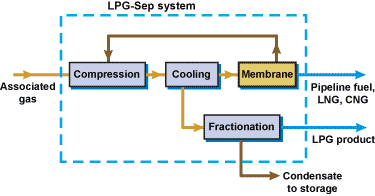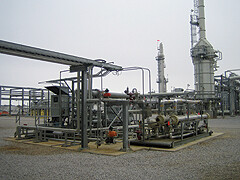LPG-Sep™ is a winner because membranes easily get the heavies out of the effluent gas at benign conditions — no cryogenics, no absorbents, no hassle.
Opportunity
Associated gas often cannot be used at remote wellheads and the whole stream has to be flared — wasting a valuable resource and contaminating the environment. Recovering LPG from these flare gases saves valuable hydrocarbons and enables them to be used locally.
Membrane Solution

LPG-Sep™ Process
MTR’s LPG-Sep™ systems efficiently recover LPG from associated gas — an attractive option since LPG is easy to store and transport and can often be used locally. Associated gas is rich in heavy hydrocarbons so removing LPG and heavier fractions from the flare gas massively reduces carbon emissions and the bulk of the BTU value in the gas is recovered for local use. In some situations use of LPG-Sep™ enables the remaining methane to be easily recovered in simple LNG or CNG units, to be used as fuel gas or to be piped to a nearby consumer.
LPG-Sep™ unit operations comprise (i) conventional compression to 350 psi;
(ii) cooling and C3+ condensation by chilled water at 60°F;
(iii) membrane gas separation to lean out the gas;
(iv) fractionation to produce spec LPG and condensate.
Benefits
- LPG recovery using simple gas processing at ambient temperature and moderate pressure
- No cryogenics, no absorbents, no chemicals, no effluents
- Unattended operation at remote locations
- Skid mounted equipment, can be trucked to site

Demonstration LPG-Sep™ unit operating at a US Gulf Coast location
System Performance
- Feed flow rate: 2-50 MMSCFD
- Feed NGL content: 5% to 50%
- LPG Recovery up to 95%
- Typical payback 6 to 18 months
Application Options
- Wellhead LPG recovery
- Dewpointing
- Flare gas recovery
- Debottlenecking